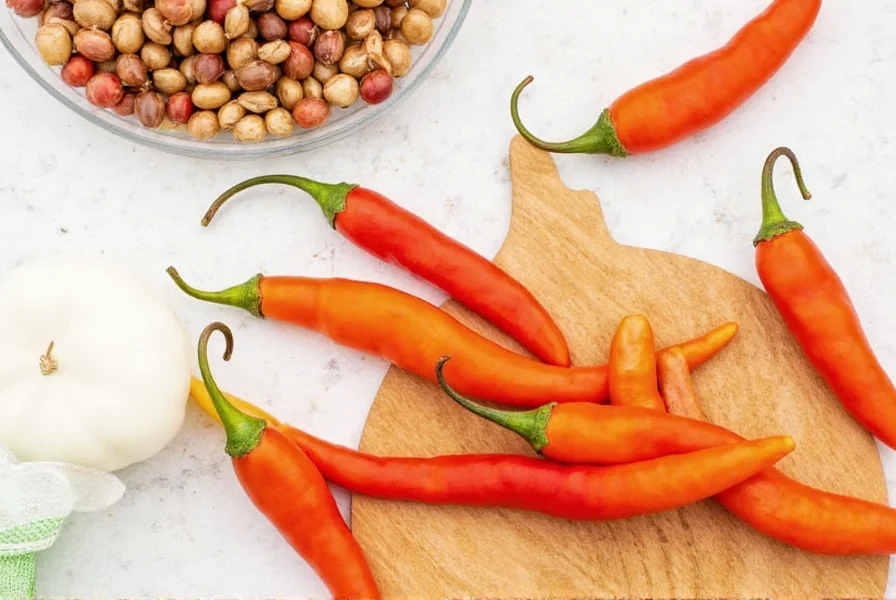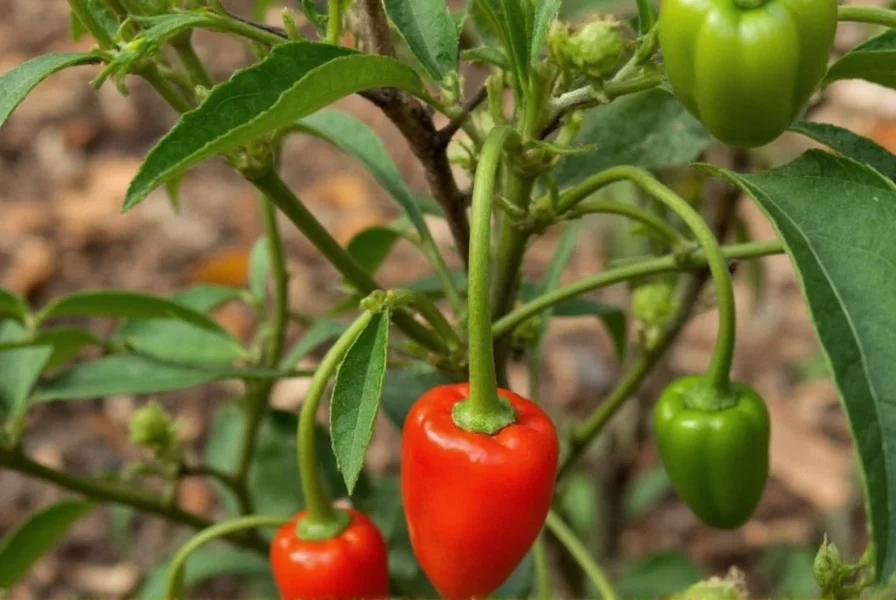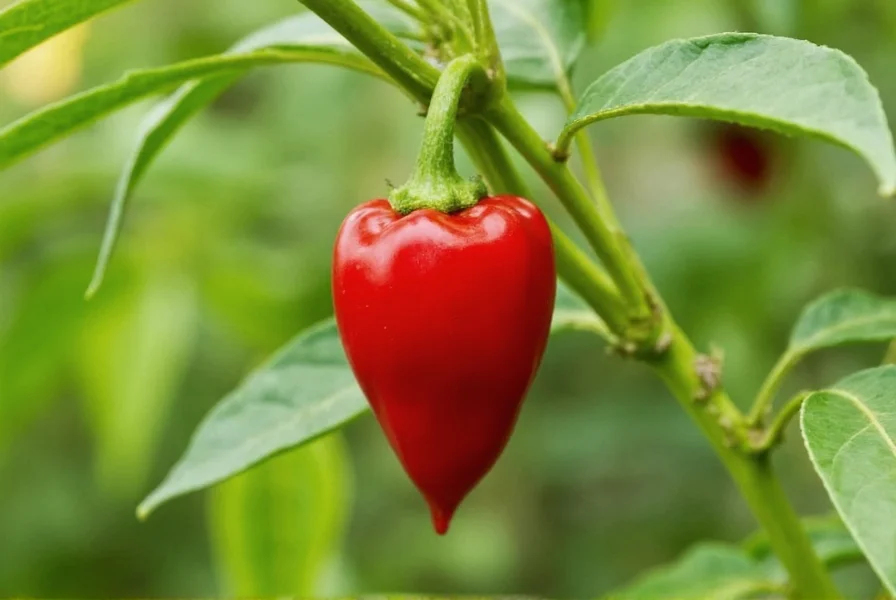Arbol peppers measure 15,000-30,000 Scoville Heat Units (SHU) - making them 2-12 times hotter than jalapeños but milder than habaneros. This places arbol peppers firmly in the medium-hot range, with a complex smoky-nutty flavor profile that sets them apart from single-note hot peppers. If you're wondering exactly how hot an arbol pepper is and whether it's right for your cooking needs, you've found the definitive guide.
The chile de árbol, or arbol pepper, hails from Mexico and has become a global favorite among spice lovers. Its name literally means "tree chili" in Spanish, reflecting its tall, woody plant structure. This slender, red pepper packs serious heat balanced with distinctive nutty smokiness that makes it a kitchen staple for serious cooks.

Used in salsas, soups, stews, and infused oils, the arbol pepper is versatile in both dried whole form and crushed flakes. Let's explore what makes this pepper special beyond just its heat rating.
What Is the Scoville Scale?
Invented by pharmacist Wilbur Scoville in 1912, the Scoville scale measures chili pepper heat through Scoville Heat Units (SHU), reflecting capsaicin concentration. While the original method involved human taste testing, modern measurements use high-performance liquid chromatography (HPLC) for precision, though SHU remains the standard culinary metric.
| Pepper | Scoville Heat Units (SHU) |
|---|---|
| Bell Pepper | 0 |
| Jalapeño | 2,500–8,000 |
| Arbol Pepper | 15,000–30,000 |
| Cayenne Pepper | 30,000–50,000 |
| Habanero | 100,000–350,000 |
Understanding these measurements helps contextualize arbol pepper heat. At 15,000-30,000 SHU, arbol peppers deliver noticeable heat that's manageable for most spice enthusiasts while still providing significant kick.
Arbol Pepper Flavor Profile and Culinary Uses
What truly distinguishes arbol peppers isn't just heat—it's their complex flavor profile. When dried, they develop pronounced smoky, nutty characteristics with subtle floral undertones. This complexity makes them ideal for dishes where you want heat with dimension.

- Salsas: Essential for traditional Mexican salsas like salsa roja and salsa de molcajete, where their heat holds up during cooking
- Stews and Soups: Add whole dried peppers to braises for gradual heat infusion that permeates the entire dish
- Oil Infusions: Create homemade spicy oil by steeping dried peppers in olive or avocado oil for drizzling over finished dishes
- Seasoning Blends: Grind into powder and mix with salt, garlic, and lime for custom seasoning with balanced heat
Unlike some peppers that lose potency during cooking, arbol peppers maintain consistent heat throughout long-simmering dishes, making them ideal for complex recipes.
Comparing Arbol with Other Popular Peppers
| Pepper | Heat Level (SHU) | Flavor Notes | Best Use |
|---|---|---|---|
| Arbol | 15,000–30,000 | Smoky, nutty, slightly fruity | Salsas, soups, infusions |
| Jalapeño | 2,500–8,000 | Grassy, fresh, mild earthy tones | Fajitas, nachos, raw salsas |
| Cayenne | 30,000–50,000 | Earthy, sharp, bright | Dried spice blends, powders |
| Hatch Green Chile | 2,500–8,000 | Roasty, sweet, vegetal | Green chile sauces, stews |
| Habanero | 100,000–350,000 | Tropical fruit, citrus, floral | Hot sauces, Caribbean dishes |
While cayenne delivers more intense but one-dimensional heat, arbol offers nuanced flavor that enhances rather than overwhelms dishes. Compared to jalapeños (2,500-8,000 SHU), arbol peppers provide 2-12 times more heat with superior depth of flavor.
5 Practical Tips for Using Arbol Peppers
- Toast Before Use: Lightly toast whole dried peppers in a dry skillet to enhance their natural smoky aroma and deepen flavor complexity
- Control Heat Level: Remove seeds and white membranes (where 80% of capsaicin resides) for milder results while retaining flavor
- Create Custom Infusions: Steep 2-3 dried peppers in 1 cup vinegar or oil for 2-4 weeks to make versatile spicy bases
- Adjust Cooking Method: Use whole peppers for subtle background heat; crush for immediate spice impact in finished dishes
- Balance Flavors: Pair with citrus, garlic, tomatoes, or even chocolate to complement arbol's unique profile

Buying Guide: Finding the Best Arbol Peppers
When selecting arbol peppers, look for these quality indicators:
Whole Dried Peppers
- Color: Vibrant red to reddish-orange (avoid dull or brownish peppers)
- Texture: Dry but not brittle with crinkled skin indicating proper drying
- Smell: Rich, earthy aroma (musty smells indicate poor quality)
Crushed or Ground Products
- Packaging: Sealed containers or vacuum-sealed bags preserve freshness
- Labeling: "100% ground arbol" without fillers or anti-caking agents
- Trusted Brands: La Costeña, El Yucateco, and Mexi-Peñ consistently deliver quality
| Product | Form | Key Features | Best For |
|---|---|---|---|
| Mexi-Peñ Ground Arbol Chili | Ground | Smooth texture, rich color, no additives | Spice blends, quick seasoning |
| La Costeña Dried Arbol Peppers | Whole dried | Consistent heat, excellent flavor | Cooking, infusion, grinding |
| El Yucateco Red Hot Sauce | Liquid sauce | Vinegar-based, tangy finish | Tacos, eggs, soups |
Proper Storage for Maximum Freshness
- Whole Peppers: Store in airtight container away from light; maintains quality for up to 1 year
- Ground Powder: Keep in sealed glass jar in cool, dark place; best within 6-12 months
- Infusions: Refrigerate after opening; use within 3-6 months
Safety Tips for Handling Spicy Peppers
- Wear gloves when handling multiple peppers or fresh varieties
- Avoid touching eyes or face - capsaicin causes prolonged irritation
- Keep dairy nearby - milk or yogurt neutralizes capsaicin better than water
Frequently Asked Questions About Arbol Peppers
How hot is an arbol pepper on the Scoville scale?
Arbol peppers measure between 15,000 to 30,000 Scoville Heat Units (SHU). This places them in the medium to hot category - significantly hotter than jalapeños (2,500-8,000 SHU) but milder than habaneros (100,000-350,000 SHU).
How does arbol pepper heat compare to jalapeño?
Arbol peppers are substantially hotter than jalapeños. While jalapeños range from 2,500 to 8,000 SHU, arbol peppers range from 15,000 to 30,000 SHU - making them approximately 2-12 times hotter than jalapeños. If you're accustomed to jalapeño heat, start with less arbol pepper than you would jalapeño in recipes.
Are arbol peppers the same as cayenne peppers?
While similar in appearance and often confused, arbol and cayenne peppers are different varieties. Arbol peppers (15,000-30,000 SHU) are slightly milder than cayenne peppers (30,000-50,000 SHU). Arbol peppers have a more complex flavor profile with nutty, smoky notes, while cayenne tends to have a sharper, more straightforward heat.
What do arbol peppers taste like besides being hot?
Beyond their heat, arbol peppers offer a complex flavor profile with distinct smoky, nutty notes and subtle fruity undertones. When toasted, they develop even deeper earthy flavors. This complexity makes them more versatile than many single-note hot peppers, adding dimension to dishes beyond just heat.
Can I substitute arbol peppers for other chili peppers?
Yes, but with considerations for heat level and flavor. For similar heat, you could substitute cayenne pepper (use slightly less as cayenne is hotter). For milder heat, use more jalapeño. For the closest flavor match, guajillo peppers offer similar smokiness but with less heat. Remember that each pepper brings unique flavor characteristics to a dish.
Conclusion: Maximizing Arbol Pepper Potential
Understanding that arbol peppers deliver 15,000-30,000 SHU of complex, smoky heat makes them invaluable for cooks seeking to elevate dishes beyond basic spiciness. Their distinctive nutty flavor profile—unmatched by single-note hot peppers—makes them ideal for salsas, soups, and infusions where heat needs to complement rather than dominate.
When shopping, prioritize vibrant red color and proper drying in whole peppers, or trusted brands for ground products. Remember that proper storage maintains both heat and flavor for up to a year. Whether you're making authentic salsa roja or experimenting with spicy chocolate, the arbol pepper's balanced heat and nuanced flavor make it a kitchen essential worth mastering.










 浙公网安备
33010002000092号
浙公网安备
33010002000092号 浙B2-20120091-4
浙B2-20120091-4